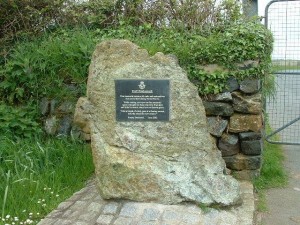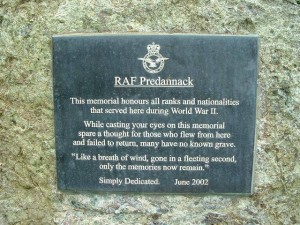RAF Predannack
Located 2 miles South of Mullion on A3083 Helston-Lizard Road
NGR SW685162
This short history of RAF Predannack has been reproduced from
ACTION STATIONS 5: Military Airfields of the South West by Chris Ashworth
The book has been out of print for almost 20 years but still provides a fantastic insight into our local military airfields.
Intruding was always an exciting business but never more so than on the night of June 20/21 1943. Led by their CO, Wing Commander Allington, four crews of 264 Squadron set off from Predannack in their Mosquito NF IIs for Lake Biscarosse, south-west of Bordeaux. This was the home of 1 (F) 129 which flew the Bv 138 three-engined flying boats which were making a nuisance of themselves over the Bay of Biscay. Despite poor weather on the outward flight they found the base, shot down two Bv 138s in the circuit, and then set about other boats on the lake. Smoke and flame indicated some success but in the early dawn light it was difficult to make detailed claims. Confirmation came later that two Bv 138 and two of the huge six-motor Bv 222 flying boats had been destroyed on the water and hangars and other installations left on fire. All the Mosquitoes returned safely from an operation which made up for many earlier disappointments and put Predannack firmly on the night fighter map.
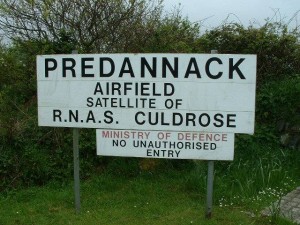
The airfield, built on the bleak Lizard peninsula using 780 acres of rough heathland, was opened in May 1941 as a satellite for RAF Portreath. 247 Squadron arrived on June 18 and found things very primitive with most of the accommodation incomplete and the airfield a sea of mud and confusion. At first there was very little action for the Hurricanes but in August the Squadron commenced sweeps over France. 247’s first confirmed victory came in September when an He 111 was destroyed at night, but the main task remained intruder operations on which it was joined by 118 Squadron in December.
Accommodation had been a terrible problem during 1941 when the `Polrurrian Hotel’ was used as an officers’ mess and most of the personnel were dispersed in billets all over the peninsula. Good weather during the autumn enabled progress to be made with camp buildings, however, and in November the communual sites alongside the Helston-Lizard road were completed.
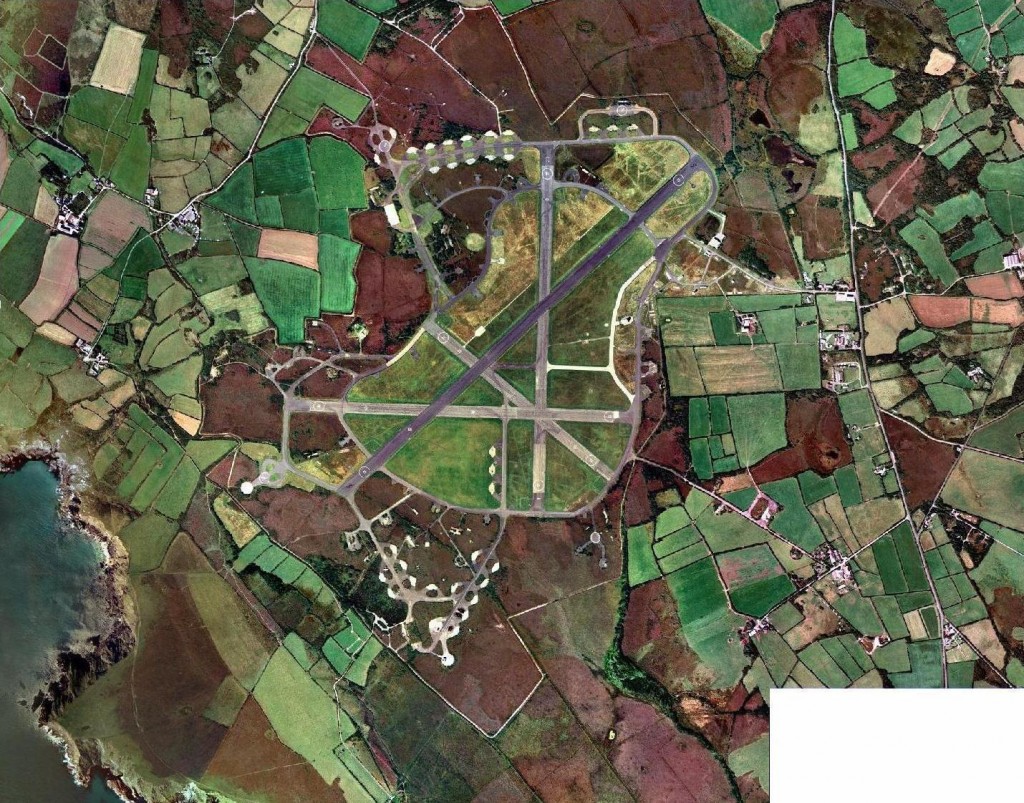
During the same month an unusual night fighter unit arrived. This was 1457 Flight which flew Havocs fitted with a Turbinlite searchlight in the nose, intended to illuminate the target while a single-seat fighter, in this case a Hurricane of 247 Squadron, attacked it. The first operational patrol was made on January 29 1942, but the first contact was not until June 30 when a Ju 88 was illuminated, but evaded by stall turning. Another was contacted on August 4 but was again lost before the Hurricane could get into firing position. The use of another squadron to act as attacker proved unsatisfactory and a Hurricane Flight was added to the unit strength just before it became 536 Squadron and left Predannack. The Luftwaffe also tried its hand at intruding, the first attack being made on October 12 1941 by a Ju 88 which followed a Beaufighter on the approach and shot up the airfield. On December 14 two aircraft on the airfield were damaged during another raid.
After several detachments at Predannack, 600 Squadron moved in completely during December for anti-shipping sorties and interception reconnaissance aircraft. Numerous other fighter squadrons used Predannack as forward base for Rhubarbs and bomb escort duties. The latter support daylight operations against the Scharnhorst, Gneisenau and Prinz Eugen which absorbed 37 per cent of Bomb Command’s effort between December 1941 and January 20 1942.
Three 1,000 lb (454 kg) bombs we dropped during January but caused no casualties or damage. Much more difficult to deal with was the severe weather which badly damaged some of the Blister hangars providing the only aircraft protection at Predannack. On March 7 600 Squadron crew found an He 115 floatplane just off Lizard Point and quickly despatched it, but things were n so easy for Pilot Officer Harvey and Flying Officer Wicksteed (later a Daily Express columnist) on June 7 when they shot down an He 111 but were then forced to ditch after accurate return fire. They got themselves in a dinghy and finally reached Portreath beach under their own steam. 600 Squadron left suddenly for RAF Church Fenton in September and was replaced by 406 (RCAF) Squadron which saw little action during its three-month stay, their Beaufighters being used mainly for search and rescue work.
The forward position of Predannack made it a natural place for emergency landings, and it provided a haven for many heavies during 1942. On October 20 a Liberator of 224 Squadron crash-landed after being damaged by its own depth charges during an attack on a U-boat. It burst into flames on touchdown but the crew were dragged out safely.
The geographical location of the airfield also resulted in it being used as a jumping-off point for North Africa during November/December 1942. The sheer volume of traffic overwhelmed the normal ferry despatch unit at Portreath and all the larger airfields in the southwest, however unsuitable, were pressed into service. Thus part of the 60th TCG, their C-47s carrying paratroopers, staged through on November 7, and the majority of the 81st FGs P-39s were refuelled at Predannack before the long flight across the Bay and around Spain and Portugal, made at the turn of the year.
Meanwhile a detachment of 263 Squadron Whirlwinds from RAF Warmwell arrived for anti-shipping strikes. They had started using bombs in September and rapidly built-up a reputation on Roadsteads. In December 604 Squadron moved in for Bay patrols and 248, a special coastal Beaufighter squadron, also arrived to help combat the flak ships which were causing so much trouble to torpedo strike aircraft. Although the station remained in 10 Group during 1943 nearly all operations were maritime-orientated, and when a Wellington of 304 Squadron made a hasty landing on February 9 after being damaged by Ju 88s, four Beaufighters of 248 took off, chased the enemy and shot down all three.
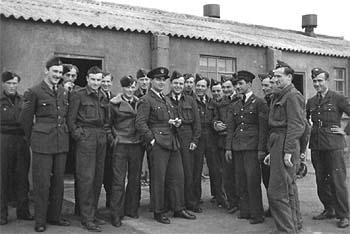
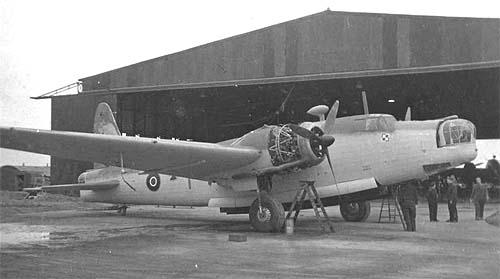
No 141 Squadron, commanded by the famed Wing Commander Bob Braham, DSO, DFC, arrived with night fighter Beaufighters tasked with escorting shipping strikes, intruding and Insteps. Not overawed by this fighter presence, 248 continued to maraud over the Bay, destroying a Ju 88 on March 10 and an Fw 200 Condor two days later. After the first of these combats the Beaufighter suffered an engine failure but the Free French pilot, Lieutenant Maurice Guedj, flew it 200 miles (322 km) back to base – a considerable feat, for the number of aircraft lost due to engine failure far outweighed those lost by enemy action. There were other reasons too, high spirits or over-confidence leading to the loss of X7751 of 141 Squadron on April 26 when it lost a wing after hitting a but during an airfield beat-up.
No 263 Squadron’s Whirlwinds returned for convoy patrols in March and in April 264 Squadron brought in the first Mosquitoes. They were used for shipping recce over the western approaches and on night Rangers, the sortie rate gradually increasing, 248 and 264 flying over 1,100 hours in May. Detachments from 307 and 456 Squadrons arrived in June as more and more Insteps wee flown to try and keep the Bay of Biscay clear of the Luftwaffe.
The increasing numbers of American bombers operating over France in daylight resulted in many unannounced visitors. Usually they arrived in ones or twos, but on May 1 1943 the 306th BG was badly mauled as they withdrew from St Nazaire and 15 B-17s put down at Predannack, three of them badly damaged and carrying dead and wounded. One of the aircraft of 423 Squadron received several hits with resultant fires in the radio compartment and the tail. Senior Sergeant Maynard Smith, finding his ball turret guns inoperative climbed out just in time to see two other gunners and the radio operator bale out. Smith, however, stayed to fight the fires, gave first aid to the badly wounded tail gunner, and even found time to fire the waist guns at Fw 190s still attacking the formation. Escaping oxygen fuelled the fires and ammunition boxes started to explode- he threw them out through a gaping hole -and for 90 minutes continued to fight the fires as the aircraft headed for the English coast. Lieutenant Lewis P. Johnson put the badly damaged aircraft down at Predannack and the wounded were rushed off to hospital. A few weeks later Sergeant Smith was awarded the Legion of Honor – America`s equivalent of the VC- the first to a living member of the VIIIth Air Force.
During 307`s stay at Predannack HMS Sheffield was used as a radar picket ship to extend fighter control further into the Bay. It soon brought results, the Poles destroying five and damaging six out of the 12 aircraft intercepted. Five crews of 618 Squadron, a special Mosquito unit, were posted in during October and were absorbed by 248 which had just received its first Mosquito XVIIIs.This was an anti-submarine version of the aircraft, equipped with a 6-pdr (57 mm) gun capable of punching a hole through a submarine’s pressure hull. Operations with the aircraft started on October 24 and a fortnight later a U-boat was found on the surface. Several shells struck the base of the conning tower causing a rapid crash dive, but despite the good performance of the guns in service no submarine was sunk by the 6-pdr during 248 Squadron service.
Other changes made late in 1943 resulted in Typhoons of 183 Squadron arriving at Predannack to roam over the Brest peninsula, and Mosquito IIs of 157 replacing 307 on shipping patrols over the western approaches. They soon drew blood, claiming a Ju 290 four-engined maritime reconnaissance aircraft on November 20, together with one of the four Ju 88s escorting it. Eleven days later three Ju 88s were shot down for the loss of a Mosquito and crew. But with the New Year came bad weather and a reduction in activity, both 157 and 183 Squadrons leaving soon afterwards.
The runways were extended during 1943 and this enabled continuous operation by larger aircraft. 304 Squadron moved out of RAF Davidstow Moor in December and spent nearly three months operating Wellington XIVs from Predannack. Bad weather reduced U-boat sighting opportunities but during January 1944 the squadron destroyed one of the three attacked. The Leigh Light Wellingtons were replaced by Liberators of 311 (Czech) Squadron in February. They were equipped with rocket projectiles for operations against U-boats making the final run home on the surface. Unfortunately the enemy was now extremely cautious and opportunities to use this specialised equipment were few.
No 151 Squadron brought its Mosquito XIIIs from RAF Colerne in March and started shipping attacks during which its total score reached 100 aircraft on April 11 when seven German aircraft were destroyed for the loss of two Mosquitoes. At the end of April 1944 Nos 1 and 165 Squadrons formed a Spitfire IX Wing at Predannack to catch Ju 88s attacking shipping in the south-west. They were frequently scrambled but communications delays prevented any interceptions. Shipping recces were also flown and on May 19 resulted in a strike being mounted on four merchantmen off Ushant. The Spitfires escorted coastal Beaufighters and tried to draw the flak as the attack went in. One destroyer escort was sunk and two merchantmen were damaged for the loss of two Beaufighters.
In May the Leigh Light Wellingtons of 179 joined 311 Squadron and invasion rumours grew stronger as the month progressed. The Spitfire Wing was ordered to give continuous cover to a convoy assembling near Falmouth on June 4 and were amazed to see the size of it. For the next two days it continued to grow, and at dawn on the 6th eight 1 Squadron aircraft on their way to Brittany found themselves over a never-ending stream of ships- the invasion was on. During the following week operations were hampered by low cloud but several road convoys were strafed and, with the Luftwaffe noticeably absent, the Spitfires were armed with 500 lb bombs and sallied out to attack radar installations on the French coast. On June 15 they attacked shipping in St Peter Port, Guernsey, before leaving for Harrowbeer four days later.
Both 179 and 311 Squadrons were fully occupied with Cork patrols, designed to block off the English Channel and Irish Sea to U-boats. On the evening of the invasion 15 U-boats left Brest but an hour later U-415 was attacked by a Wellington of 179 Squadron and badly damaged. Unable to dive she limped back to Brest with U-256. They were luckier than the U-955 and U-970 which were sunk during the night by other 19 Group aircraft.
The U-boat war moved away from the Channel area in the summer of 1944 and with it went 179 and 311 Squadrons. 152 (GR) Wing was disbanded on September 7 and Predannack became a rest and re-equipment base for fighter units. The first cusomters were 264 and 604 Squadrons of 142 Wing which arrived late September from the Continent. They left early in December and 33 and 222 Squadrons flew in to convert from Spitfires to Tempest Vs.
From a peak strength of 3,600 the numbers had again dropped to below 2,000 and nearly everyone was accommodated on the base. In February 1945, 349 (Belgian) and 485 (RNZAF)Squadrons started re-equipment with Tempests but serviceability problems delayed the work-up so much that the latter unit was given Typhoons and then sent back to the Continent in April with Spitfires!
VE-Day was celebrated at Predannack without any flying units, but immediately afterwards the Mosquitoes of 151 and 406 Squadrons returned. With the abrupt end of the war against Japan 406 disbanded, leaving 151 to linger on until the end of May 1946 when it left for Exeter. Meanwhile the Battle of Britain display on September 15 produced over 4,000 visitors to this isolated station. They were treated to the usual varied display including a flypast by nine Mosquito XXXs of 151 Squadron returning from a mass formation over London.
On June 1 1946 the airfield was reduced to Care & Maintenance parented by Exeter and it seemed certain that it would soon be returned to heathland. It did indeed lie abandoned for several years, but its very isolation was the reason for rekindled interest. Barnes Wallis had been conducting experiments with variable geometry models for Vickers and Thurleigh and by 1951 was ready for more extensive testing, including free flight. Predannack was selected and a launching track built across the airfield alongside 06/24 runway. Trials were due to start in September 1947 but constant delays were experienced with the Wild Goose test vehicles and launching gear and it was not until April 1952 that a flight was made. Control dificulties resulted in the model hitting a building and being wrecked, but tests continued and altogether 31 powered flights were made, at least one by an updated version, the Swallow, before Vickers stopped work on the project.
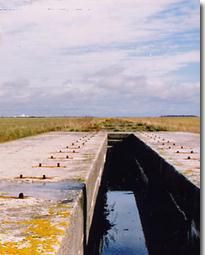
Predannack was abandoned in October 1954.
Four years later, with helicopter training expanding at Culdrose, a relief airfield was needed and Predannack proved ideal. it was taken over by the Fleet Air Arm on December 15 1958 for elementary training of helicopter pilots away from the main airfield at Culdrose. The 06/24 runway was cleared and resurfaced in 1971 to enable fixed-wing aircraft to land and several were flown in for the RN Fire Fighting School which was established on the airfield.
The airfield is still in use by Culdrose, a new administrative block and control tower having been built in recent years.
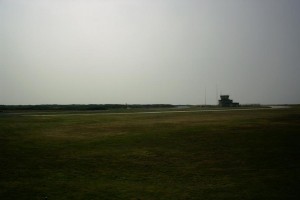
Evidence of the wartime airfield abounds, with shelters and crumbling dispersals visible on the eastern side of the A3083, and a mixture of derelict and refurbished buildings on the airfield side. Some of the latter are in use as holiday villas and self-catering chalets, while another houses the Hervan Road riding stables.
